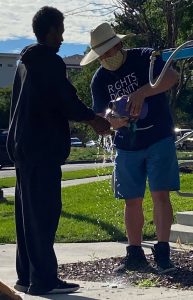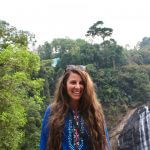Ean Thomas Tafoya
Denver, Colorado
As Field Advocate and founder of the Headwaters Protectors, a mutual aid group serving the unhoused, Tafoya is innovatively fighting for clean and healthy water for all. Tafoya was raised a proud Xicano and his Indigenous ancestors are Jicarilla Apache and Ohkay Owingeh from the Headwaters of the Rio Grande in Southern Colorado and Northern New Mexico. Tafoya is a performance artist whose music, dance, and poems focus on themes of water and justice. Tafoya is a tireless advocate and community organizer, whose accomplishments converge in the area of bringing people together to recognize the intersectionality of water issues in Colorado and nationwide.
Ean was honored as a River Hero at River Rally 2021.
This interview was conducted by Carly Schmidt on February 24, 2021. Learn more about Ean’s work.
You will be honored as one of our 2021 River Heroes for the full scope of your work in Denver and surrounding communities. How did you come into the community work that you are engaged in now?
I came into this world an environmentalist. I was born on Earth Day and my mom always said what a blessing it was to be born on this day of action. She taught me about rivers that had caught on fire and how people came together. My mother was a social worker who spent the majority of her life working with Latinos and low-income families and now she runs housing in Commerce City, which is one of the most polluted cities in Colorado. But I didn’t really understand environmental justice until I was older. We moved to a house in North Denver that had remediated superfund soil and I still didn’t understand how environmental justice affected me, even though I could see a smokestack from my house.
I wanted to be a teacher. I was a Montessori educator and I was involved in my community but I didn’t stress that much. I wasn’t thinking about city or statewide policy and how it affected me. I set out on a path to become a horticultural therapist and brought composting to campus, fought for bike lanes and food access—a lot of things that are more about personal choice and less about systemic justice. I got recruited by the Mayor of Denver to work on an urban agriculture initiative, then I became the aid to the director of community affairs, and from there I worked in legislative services in Denver City Council. I was there for about 3 years and I started to see (around I-70 in particular) environmental racism with multiple projects being pushed on a community and ignoring the feedback of residents. This was really when I became an environmental justice advocate.
I quit my job and ran for city council at the same time that homelessness was outlawed. I didn’t win, but I ran on a platform that I knew I could influence in a first term, which was managing our waste and protecting our water. After a time working in government affairs, I decided to come back and work on the issues that I was really passionate about. We took on a huge lobbyist (that outspent us 400:1) and passed the first law requiring solar panels and green roofs on large buildings in Denver. Building on this win, I took on other issues around democratization, mental health, and healthy food for kids. Eventually, I made my way to D.C. with EarthJustice. We were fighting a refinery when I met my current company, GreenLatinos. I knew them for 6 months and in that time I became their first organizer in the United States and I have been with them for almost 2 years.
I think water issues are the highest tier of environmentalism because water touches everything and is a hard place to break into. But I got my water certification from the One World One Water Center and was able to start this work through GreenLatinos. But I have been doing work with the homeless community for many years.
I tried the channels for so long through nonprofits and government and they failed. I was on those national calls with everyone who was fighting against water shutoffs. But we cannot forget about the people who don’t have housing who desperately need water. So [Headwaters Protectors] went out and just started providing it. One of my side hustles is events and festivals. I had worked on some of the largest festivals in Colorado so I knew that we could bring water to any site, we could handle trash, and that these problems were solvable. We said, “if they’re not going to lead then we’re going to lead.” Seven months later, Headwaters Protectors made the decision to incorporate as a nonprofit. We raised enough money to buy our own water truck and we’re going to keep working and standing in the gap of the failed system.
What initiatives are taking up most of your time and energy at this moment?
Headwaters Protectors has been very reactionary. We are showing up at sites and taking the trash. I have organized a 37 square block cleanup, I have participated in the largest cleanups in the city. For me, I feel like trash is a great way to get people out in their community. We’re currently in a fight to provide porta-potties for the homeless community that the Mayor of Denver is actively fighting against, but there are still complaints about people relieving themselves in the streets. We’re fighting to get water to these communities regularly and we’re fighting to get trash picked up in Denver. We have trained over 200 people now and, when we fill hundreds of bags of trash and the city doesn’t pick them up for 4-5 days, it creates more issues. In the short-term, we’re focused on regular trash service, regular water service, and sanitation access.
A spinoff of Headwaters Protectors is an arts alliance. For example, Mo Hnatiuk runs Arise Festival, which deals with 25,000 people camping at one time. Denver has a 25,000-person homeless problem. These safe outdoor sites work because it’s managed infrastructure, not this chaos that we’re seeing now. These small-scale solutions where we provide water and sanitation to 50 people isn’t cutting it, so we’re fighting in the regional council of government and other localities to scale these sites. It’s a Green New Deal in our mind because all these festival workers are currently unemployed, yet they have the experience to provide services to the unhoused. They deal consistently with individuals who are intoxicated, on hallucinogens, or are dealing with mental health issues. They also know how to deal with people without the police showing up to every problem. We certainly aren’t watching the police brutalize people who are having mental health situations at festivals. So we think that we are the right people for the job. We can also help bridge the gap with a community that is hesitant about safe outdoor solutions because we’ve done the work already.
Your website bio says “he loves to dance whether it be at a concert or in politics.” What is the connection between art and community activism and how has your art served your community and vice versa?
Art is an expression of what people are feeling and it is a chance to bring people together to live their values. In the festival world, there’s this concept of “I wish the rest of the world held this much joy and hope and light,” and I always wonder why we can’t make this our reality. Politics is a dance sometimes, but you are trying to be in the lead so you can drive the narrative. I have danced since I was really young and I like to write and perform slam poems as well. I think they all go hand-in-hand.
How has art served your community organizing work at GreenLatinos?
The arts community is something that we definitely should leverage to affect change in our communities. In the GreenLatinos movement, we did pop-up silent discos for the Clean Water Act and it was really a party. I did very little talking and we all knew why we were there. For me, coming from the music world, I have learned that people are really responsive to pop-ups and I like the concept because it tests a community’s response. Sometimes we have to respond and protest and be present. I had a chance to partner with GreenLatinos for Earth Day last year and involved the poet laureate for the state of Colorado, Bobby LeFebre (who is now a member of GreenLatinos). Los Mocochetes, an amazing band in Denver, are also GreenLatinos members. The arts are just a great way to bring people together and convey our power.

Ean Thomas Tafoya washes the hands of a man in Denver’s unhoused community.
It goes without saying that this kind of community work is not easy. What keeps you motivated in this work?
The community and GreenLatinos as a space keep me going. I am able to have conversations with people in the community where I don’t need to tiptoe around topics, so these identity associations are very helpful. I also think multi-racial organizations with equity at the center like the Next 100 Coalition in Colorado. That space was one of the healthiest spaces I have participated in during the height of the pandemic.
When I am having the hardest time, I go to the water. I live by some beavers and I go to the water with my personal medicine and I build a connection with the water and that gives me hope. Everyone knows what it feels like to have your feet in the water.
What keeps me going in the face of the homelessness crisis is remembering that it could be me. When you wash the hands of someone who is crying and says, “I haven’t washed my hands in five days,” that’s enough to fill your heart for the rest of your life. Or when you show up and it’s 7 degrees and you put warm clothes on someone who might shiver to death. When you make that connection with your humanity, that keeps you going more so than “we lost this vote.” That direct action feels so powerful.
What is the story behind the hand-washing photo?
This was a man in Denver’s unhoused community who was crying and thanking us for the water. Not only are the unhoused othered and not only have we passed anti-homelessness laws, but COVID has made people even more inhumane and distant—no you can’t come into my store or I don’t know who you are—and prejudices have risen to another level. And there is no doubt that there is a connection between Indigenous and Black people and their access to water and housing.
What does it mean to you, personally, to be a water protector?
Being a water projector means that you are taking a role in the defense of water. It can be in a policy lens or a community, trash-collecting lens. It could also mean fighting a pipeline. Much love and solidarity to people at Line 3 and those who were at Standing Rock. Knowing the history of your water and having a relationship with it makes you a water protector. Taking action is being a water projector. Ensuring that everyone has access to this life-giving water makes you a water protector.







